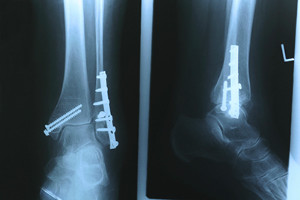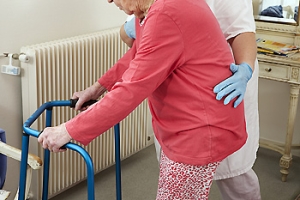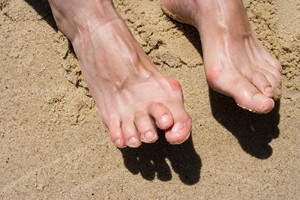
Possible Causes for Changes in the Feet During Pregnancy
 There are several physical changes that accompany pregnancy which can possibly lead to foot pain. This may be a result of the increased weight the growing fetus puts on the body, hormonal changes, or from eating foods that have high levels of sodium. Many pregnant women notice it may become difficult to complete daily activities when their feet are swollen. Research has indicated it is beneficial to elevate the feet as often as possible, in addition to performing gentle foot stretches. Comfort can be found when shoes fit properly, and the correct shoe size can be determined when the feet are measured during the day. If you would like additional information about the effects pregnancy can have on the feet, please schedule a consultation with a podiatrist.
There are several physical changes that accompany pregnancy which can possibly lead to foot pain. This may be a result of the increased weight the growing fetus puts on the body, hormonal changes, or from eating foods that have high levels of sodium. Many pregnant women notice it may become difficult to complete daily activities when their feet are swollen. Research has indicated it is beneficial to elevate the feet as often as possible, in addition to performing gentle foot stretches. Comfort can be found when shoes fit properly, and the correct shoe size can be determined when the feet are measured during the day. If you would like additional information about the effects pregnancy can have on the feet, please schedule a consultation with a podiatrist.
Pregnant women with swollen feet can be treated with a variety of different methods that are readily available. For more information about other cures for swollen feet during pregnancy, consult with Dr. Mark Spier from Maryland. Our doctor will attend to all of your foot and ankle needs.
What Foot Problems Can Arise During Pregnancy?
One problem that can occur is overpronation, which occurs when the arch of the foot flattens and tends to roll inward. This can cause pain and discomfort in your heels while you’re walking or even just standing up, trying to support your baby.
Another problem is edema, or swelling in the extremities. This often affects the feet during pregnancy but tends to occur in the later stages.
How Can I Keep My Feet Healthy During Pregnancy?
- Wearing orthotics can provide extra support for the feet and help distribute weight evenly
- Minimize the amount of time spent walking barefoot
- Wear shoes with good arch support
- Wear shoes that allow for good circulation to the feet
- Elevate feet if you experience swelling
- Massage your feet
- Get regular, light exercise, such as walking, to promote blood circulation to the feet
If you have any questions please feel free to contact one of our offices located in Columbia and Reisterstown, MD . We offer the newest diagnostic and treatment technologies for all your foot and ankle needs.
Pregnancy and Foot Health
Many pregnant women complain about foot pain while they are expecting. Foot pain can primarily be caused by weight gain and hormonal changes taking place in the body. By understanding how pregnancy impacts the health of a woman's feet, a pregnant woman can take action to keep her feet as healthy and comfortable as possible.
Because a woman's weight changes during pregnancy, more pressure is brought to bear on both the legs and the feet. This weight shift can cause two major foot problems: over-pronation, also known as flat feet, as well as edema, which is swelling of the feet. Over-pronation occurs when the arch of the foot flattens, causing the foot to roll inwards when the individual is walking, and can aggravate the plantar fascia tissues located along the bottom of the feet. If these tissues become inflamed, a pregnant woman can experience pain in the heel of the foot as well as severe foot pain while walking or standing. Swelling of the feet, or edema, often occurs in the later stages of pregnancy. It is caused by slow circulation and water retention, and may turn the feet a light purple color.
To keep feet in good health and prevent over-pronation, pregnant women should avoid walking barefoot and be sure they are wearing shoes that offer good arch support. A device known as an orthotic can be added to regular footwear in order to provide additional support for the feet during pregnancy. Any expectant mother whose feet hurt should first check to see if the shoes she is wearing are old, worn out and not offering the proper support necessary for distributing the weight of her body during pregnancy.
To treat edema of the feet, a good start is to wear quality footwear which offers support and good circulation. Keep feet elevated whenever possible by using a foot stool while seated. Stay well hydrated by drinking plenty of water to prevent water retention in the feet. Any swelling that occurs in only one foot should be examined as soon as possible by a doctor.
Good foot health during pregnancy can help expectant mothers avoid foot pain that leads to other health problems. Massaging the feet and doing regular gentle exercise like walking aids foot health by contributing to good circulation. Supportive shoes are also a good investment that will support foot health during pregnancy.
Wearing Flip Flops May Lead To Foot Pain
 The type of shoes that are known as flip flops are popular to wear during the summer months for a variety of reasons. These may include the ease of quickly slipping your feet into them, as well as the ability to choose from bright colors and various styles. If flip flops are frequently worn, foot conditions may develop, and shoes that offer more support may be an option to consider. Pain may develop in the arch area, and heel pain is a common ailment. The foot may feel generally fatigued, and this may be a result of the toes grasping the shoe to maintain stability. It is suggested that you consult with a podiatrist if you have developed foot pain from wearing flip flops.
The type of shoes that are known as flip flops are popular to wear during the summer months for a variety of reasons. These may include the ease of quickly slipping your feet into them, as well as the ability to choose from bright colors and various styles. If flip flops are frequently worn, foot conditions may develop, and shoes that offer more support may be an option to consider. Pain may develop in the arch area, and heel pain is a common ailment. The foot may feel generally fatigued, and this may be a result of the toes grasping the shoe to maintain stability. It is suggested that you consult with a podiatrist if you have developed foot pain from wearing flip flops.
Flip-flops are not always the best choice of footwear. If you have any concerns about your feet or ankles, contact Dr. Mark Spier from Maryland. Our doctor will assist you with all of your foot and ankle needs.
Flip-Flops and Feet
When the weather starts warming up, people enjoy wearing flip-flops. Flip-flops are comfortable, stylish, and easy to slip on and off; they're perfect for any summer beach goer. However, these shoes can cause harm to the feet.
How Can Flip-Flops Affect Me Long-Term?
- Ankle problems
- Hip problems
- Lower back problems
- Pain in the balls of the feet
- Problems with foot arches
- Changes in the way you walk
Are There Injuries Associated with Flip-Flops?
Yes. Since flip-flops are relatively weak and do not provide the same amount of support as sneakers, people who wear flip-flops regularly are more susceptible to injuries. On top of that, the open nature of the shoe makes your feet more prone to other problems, such as cuts and even infections. Common injuries and ailments include:
- Sprained ankles
- Blisters
- Infections
- Cuts and Scrapes
I like Wearing Flip-Flops. Are There Safe Alternatives?
When buying flip-flops, try to find ones that have sturdy soles and that are made of high-quality materials that will support for your feet. These flip-flops will cost more but will also last longer as a result.
If you have any questions please feel free to contact one of our offices located in Columbia and Reisterstown, MD . We offer the newest diagnostic and treatment technologies for all your foot and ankle needs.
Flip Flops and Your Feet
When the weather heats up, you may want to start wearing flip-flops. However, it has been proven that these are not the ideal shoes in terms of preserving the health of your feet.
Flip flops are known to expose your feet to different types of bacteria and fungal infections. When you wear your flip flops in public, you are exposing them to staphylococcus which is a skin-irritating bacterium. Athlete’s foot is also highly contagious and can be spread when you walk around nearly-barefoot.
Another harmful effect of wearing flip-flops is that they develop blisters on the feet. This is because the thin strap rubs against the skin with each step taken. Unfortunately, when blisters pop, they cause you to be more vulnerable to pathogens you pick up by having your feet exposed.
These shoes may also cause “shooting pains”. If you have flat feet, you need arch support to keep your knees, hips, and back in alignment. If you wear flat shoes, your joints are forced to compensate which can cause injuries throughout the body.
If you constantly wear flip-flops, you should avoid doing so as they can lead to many problems for your feet. If you are experiencing any of these foot issues, you should seek help from a podiatrist right away.
What Causes a Stress Fracture to Occur?
 The foot is made up of 26 bones. When tiny cracks form in the bones, a stress fracture develops, which is typically brought upon by repetitive force or overuse. Some common causes for this condition include walking or running on uneven surfaces, sudden movements that place the feet in unnatural positions, and repeatedly jumping up or down. With that being said, it’s very common for athletes to develop stress fracture, as they often participate in activities that involve the movements listed above. Systemic conditions such as osteoporosis, may also affect the likelihood of developing a stress fracture as this condition may weaken the bones. For more information on how to treat this condition, it’s suggested that you seek the professional advice of a podiatrist.
The foot is made up of 26 bones. When tiny cracks form in the bones, a stress fracture develops, which is typically brought upon by repetitive force or overuse. Some common causes for this condition include walking or running on uneven surfaces, sudden movements that place the feet in unnatural positions, and repeatedly jumping up or down. With that being said, it’s very common for athletes to develop stress fracture, as they often participate in activities that involve the movements listed above. Systemic conditions such as osteoporosis, may also affect the likelihood of developing a stress fracture as this condition may weaken the bones. For more information on how to treat this condition, it’s suggested that you seek the professional advice of a podiatrist.
Activities where too much pressure is put on the feet can cause stress fractures. To learn more, contact Dr. Mark Spier from Maryland. Our doctor can provide the care you need to keep your pain free and on your feet.
Dealing with Stress Fractures of the Foot and Ankle
Stress fractures occur in the foot and ankle when muscles in these areas weaken from too much or too little use. The feet and ankles then lose support when walking or running from the impact of the ground. Since there is no protection, the bones receive the full impact of each step. Stress on the feet can cause cracks to form in the bones, thus creating stress fractures.
What Are Stress Fractures?
Stress fractures occur frequently in individuals whose daily activities cause great impact on the feet and ankles. Stress factors are most common among:
- Runners
- People affected with Osteoporosis
- Tennis or basketball players
- Gymnasts
- High impact workouts
Symptoms
Pain from the fractures occur in the area of the fractures and can be constant or intermittent. It will often cause sharp or dull pain with swelling and tenderness. Engaging in any kind of activity which involves high impact will aggravate pain.
If you have any questions please feel free to contact one of our offices located in Columbia and Reisterstown, MD . We offer the newest diagnostic and treatment technologies for all your foot and ankle needs.
Dealing with Stress Fractures of the Foot and Ankle
Stress fractures are small breaks in the bone that are caused by repetitive stress. They typically occur due to overuse, forcing the bones of the foot or ankle to continually absorb the full impact of each step taken. Stress fractures can also be caused by abnormal foot structure, osteoporosis, bone deformities, or wearing improper footwear during exercise.
Stress fractures are common for individuals whose daily activities cause high levels of impact on their feet and ankles. Those who run, play tennis or basketball, or practice gymnastics tend to experience these fractures more frequently. Anyone is susceptible to this problem, though. Individuals who are normally sedentary and suddenly begin an intense, high impact workout may sustain stress fractures. This is because their muscles are not yet strong enough to handle and cushion the intensity of their activity. Osteoporosis may also cause someone to get stress fractures, because the disease weakens an afflicted person's bones and makes it easier for them to break down.
Pain from stress fractures typically occurs in the general area of the fracture. Pain can also manifest as “pinpoint pain” or pain that is felt when the site of the injury is touched, and can be accompanied by swelling. It may occur during or after activity, and it may disappear while resting and return when standing or moving. Engaging in any kind of activity, high impact or otherwise, will aggravate the pain. If the intensity of the activity increases before the stress fracture has properly healed, it can cause a full fracture.
Treatment can vary depending on the individual and the degree of injury. The primary way to treat a stress fracture is to rest the hurt foot. Some fractures will heal quickly with only a little bit of rest, while others may require a long rest period and the use of crutches, immobilization, or physical therapy. Under certain circumstances, surgery may be required to install support pins around the fracture to assist in healing.
If you are undergoing a new exercise regimen in running or some other kind of high impact activity, set incremental goals on a weekly basis so you can build up muscle strength. Make sure to wear supportive shoes to better protect you feet.
If you begin to experience any symptoms of stress fractures, you should stop exercising and rest. If the symptoms persist, consult with your podiatrist. Remembering these tips can help you prevent stress fractures to your foot and ankle, and allow you to continue living normally.
Foot Stretches for Seniors
 It can be incredibly beneficial for elderly patients to regularly perform foot stretches. When a senior patient's feet are strong, as well as flexible, it may make them more likely to avoid accidentally falling. By performing stretches, you may increase your blood circulation, as well as improve your range of motion, muscle strength, and balance. One example of a foot stretch that is easily practiced is called an ankle rotation. This can be done by sitting up straight in a chair, and resting your ankle on the opposite knee. Begin rotating your ankle first clockwise, then counterclockwise, then you may switch ankles. For an additional stretch, make sure your toes are pointed straight during this exercise. For more advice on elderly foot care and low-impact exercises for the feet, it is suggested that you speak with your local podiatrist.
It can be incredibly beneficial for elderly patients to regularly perform foot stretches. When a senior patient's feet are strong, as well as flexible, it may make them more likely to avoid accidentally falling. By performing stretches, you may increase your blood circulation, as well as improve your range of motion, muscle strength, and balance. One example of a foot stretch that is easily practiced is called an ankle rotation. This can be done by sitting up straight in a chair, and resting your ankle on the opposite knee. Begin rotating your ankle first clockwise, then counterclockwise, then you may switch ankles. For an additional stretch, make sure your toes are pointed straight during this exercise. For more advice on elderly foot care and low-impact exercises for the feet, it is suggested that you speak with your local podiatrist.
Exercising your feet regularly with the proper foot wear is a great way to prevent injuries and build strength. If you have any concerns about your feet, contact Dr. Mark Spier from Maryland. Our doctor can provide the care you need to keep you pain-free and on your feet.
Exercise for Your Feet
Exercise for your feet can help you gain strength, mobility and flexibility in your feet. They say that strengthening your feet can be just as rewarding as strengthening another part of the body. Your feet are very important, and we often forget about them in our daily tasks. But it is because of our feet that are we able to get going and do what we need to. For those of us fortunate enough to not have any foot problems, it is an important gesture to take care of them to ensure good health in the long run.
Some foot health exercises can include ankle pumps, tip-toeing, toe rises, lifting off the floor doing reps and sets, and flexing the toes. It is best to speak with Our doctor to determine an appropriate regimen for your needs. Everyone’s needs and bodies are different, and the activities required to maintain strength in the feet vary from individual to individual.
Once you get into a routine of doing regular exercise, you may notice a difference in your feet and how strong they may become.
If you have any questions please feel free to contact one of our offices located in Columbia and Reisterstown, MD . We offer the newest diagnostic and treatment technologies for all your foot and ankle needs.
Exercise for Your Feet
Whether your feet are over-worked or under-worked, chances are they could benefit from some special attention. Even those who exercise regularly probably do not spend any time strengthening their feet. This can be just as rewarding as strengthening the rest of the body, since the health of your feet affects the health of the rest of the body as well, especially the ankles, legs, and spine.
For those who might not have any idea on how a foot-specific exercise might be conducted, there are several workouts that are fairly easy to perform in the comfort of ones’ home. One of the easiest is the toe rise, also known as the tip-toe. This exercise involves standing on the tip-toes for a count of 15 then resting the feet on the ground. This process should be repeated a minimum of three times a day in order to strengthen the feet.
Toe pick-ups strengthen the feet by working them in a very different way. In this exercise, small items are picked up using the toes in order to strengthen the muscles on the upper part of the feet. Once again three sets should be performed, with the item in question being held for 15 seconds then dropped. Items that may be picked up using the feet include marbles and even stationery, which works wonders for the toes and the surrounding muscles.
Yet another simple workout is the ankle pump. This can be done either upwards or downwards, but for the workout to be most effective both can be incorporated into the routine. As the term suggests, this involves lifting the foot off the floor and flexing the toes either towards the shin or towards the ground. This movement puts the feet and ankles through a large range of motion which works the muscles.
Last but not least, feet should be stretched so that the muscles can relax and recuperate. This can be done by placing both feet off of the floor and bracing oneself against the wall at a 45 degree angle. This ensures that the feet and ankles are adequately stretched once the workout is complete.
In short, giving the feet a good workout every now and then is important in order to avoid problems such as plantar fasciitis. It’s also important to warm-up or cool-down after running or vigorous walking. Foot exercises may be followed by a good foot massage. This encourages circulation in the feet as well as muscle relaxation.
How Can I Tell If I Have a Hammertoe?
 Research has found that the second toe, next to the big toe, is most likely to develop a hammertoe if an injury occurs, along with other causes. Hammertoes typically occur due to genetic factors, ill-fitting footwear, or from arthritis. This condition is most notably recognized by the appearance of the affected toe. Like its name suggests, a hammertoe will typically point downward, in a hammer-like fashion. Hammertoes can be incredibly uncomfortable and can make completing daily tasks difficult. To help ease the pain of mild hammertoes, a professional may suggest wearing custom orthotics. For more severe cases, it may be necessary to have surgery performed in order to correct this ailment. For more advice on how to treat and correct a hammertoe, please consult with a podiatrist.
Research has found that the second toe, next to the big toe, is most likely to develop a hammertoe if an injury occurs, along with other causes. Hammertoes typically occur due to genetic factors, ill-fitting footwear, or from arthritis. This condition is most notably recognized by the appearance of the affected toe. Like its name suggests, a hammertoe will typically point downward, in a hammer-like fashion. Hammertoes can be incredibly uncomfortable and can make completing daily tasks difficult. To help ease the pain of mild hammertoes, a professional may suggest wearing custom orthotics. For more severe cases, it may be necessary to have surgery performed in order to correct this ailment. For more advice on how to treat and correct a hammertoe, please consult with a podiatrist.
Hammertoe
Hammertoes can be a painful condition to live with. For more information, contact Dr. Mark Spier from Maryland. Our doctor will answer any of your foot- and ankle-related questions.
Hammertoe is a foot deformity that affects the joints of the second, third, fourth, or fifth toes of your feet. It is a painful foot condition in which these toes curl and arch up, which can often lead to pain when wearing footwear.
Symptoms
- Pain in the affected toes
- Development of corns or calluses due to friction
- Inflammation
- Redness
- Contracture of the toes
Causes
Genetics – People who are genetically predisposed to hammertoe are often more susceptible
Arthritis – Because arthritis affects the joints in your toes, further deformities stemming from arthritis can occur
Trauma – Direct trauma to the toes could potentially lead to hammertoe
Ill-fitting shoes – Undue pressure on the front of the toes from ill-fitting shoes can potentially lead to the development of hammertoe
Treatment
Orthotics – Custom made inserts can be used to help relieve pressure placed on the toes and therefore relieve some of the pain associated with it
Medications – Oral medications such as anti-inflammatories or NSAIDs could be used to treat the pain and inflammation hammertoes causes. Injections of corticosteroids are also sometimes used
Surgery – In more severe cases where the hammertoes have become more rigid, foot surgery is a potential option
If you have any questions please contact one of our offices located in Columbia and Reisterstown, MD . We offer the newest diagnostic and treatment technologies for all your foot and ankle needs.
















